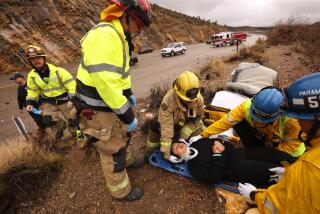SANTA MONICA : Fire Official Shares Lessons Gained in Oklahoma Bombing Rescue
A Santa Monica deputy fire chief who helped dig for survivors after the Oklahoma City bombing warned local public safety officials this week to be prepared for disaster.
Devastating earthquakes, airline crashes or terrorist attacks will occur, said Deputy Fire Chief Jim Hone, who led part of the urban search and rescue team after the April 19 blast. He briefed local emergency personnel Tuesday on the lessons learned in the Oklahoma disaster.
How well a catastrophe is handled will depend on the preparedness and organization of firefighters, police and emergency crews from a myriad of cities, counties and states, he said.
Hone arrived at the Alfred P. Murrah building 14 hours after the 4,000-pound bomb exploded.
He showed officials slides and videos of the sometimes grisly rescue effort. He described the pitfalls and successes emergency crews had in organizing the initially chaotic situation and finding and extricating the victims.
In all, 167 people died as a result of the blast.
When California search-and-rescue crews arrived at the scene, one firefighter called the frenzied action the “ant hill syndrome,” as crews frantically dug for victims without an overall plan to efficiently remove the hundreds of tons of rubble.
As the rescue operations progressed it became clear that the victims would be difficult to spot under the debris without removing all the rubble, Hone said.
Other problems ranged from below-freezing temperatures at night to a bomb scare, as searchers found a fake bomb used by the Bureau of Alcohol, Tobacco and Firearms training personnel. Also, top secret files had to be saved from the Secret Service office in the building, Hone said.
Even what seem like small issues can become big problems.
Oklahoma City residents donated homemade food for the rescue crews, but with no one in charge of the food, much of it spoiled. Consequently, at one point, a third of the task force was stricken with diarrhea and could not continue to search, Hone said.
But the wide-ranging problems were solved over several days, he said. With constant communications among the agencies, from the FBI to the Oklahoma City Public Works Department, workers set perimeters, cleared roadways and shored up the building.
In Santa Monica, public safety officials have already begun building a computer database of buildings that may be targeted by terrorists. The database includes blueprints and lists areas where employees work and how many people are likely to be in the buildings, Hone said.
In California, emergency crews already have experience with disasters ranging from earthquakes to floods to fires, he pointed out.
“California is by far the best-prepared state in the nation, and probably the world,” Hone said.
More to Read
Sign up for Essential California
The most important California stories and recommendations in your inbox every morning.
You may occasionally receive promotional content from the Los Angeles Times.










